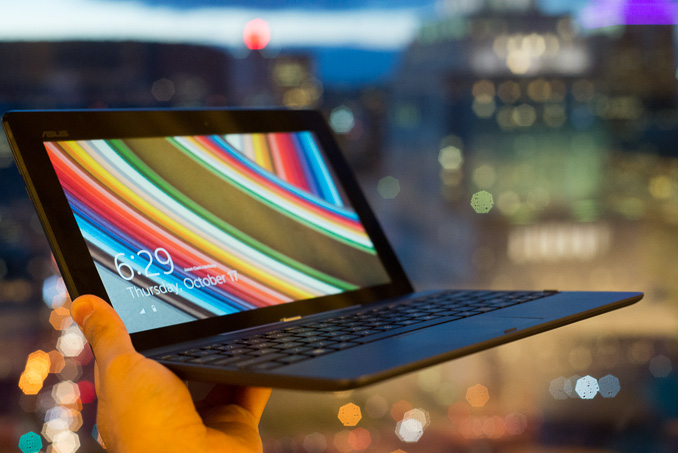ASUS Transformer Book T100 Review: Redefining the Entry-Level Windows Notebook
by Anand Lal Shimpi on October 18, 2013 12:00 AM ESTFinal Words
It’s tough to sell an entry-level Windows PC these days. You’re sandwiched between a couple of aggressive price points: the Nexus 7 at $229 and the iPad at $499. Traditionally, the PC you’d get between those price points would have mechanical storage, the cheapest of cheap TN panels, be bulky as possible, an unimpressive keyboard/trackpad and have 2.4GHz-only WiFi. About the only solace would be that it’d have some insanely quick Core architecture CPU inside, which more or less didn’t matter since the overall experience was hampered so much by the spinning disk inside. Thankfully, times are changing.
Assault first and foremost comes from Google’s latest lineup of Chromebooks. The HP Chromebook 11 addresses many of these concerns but with a fairly limited OS and silicon that’s honestly a bit too slow, even for the target market. But you do get an awesome keyboard, eMMC based storage, and an IPS panel among other things.
The Transformer Book T100 is really the Wintel camp’s answer to the Chromebook onslaught. Compared to the traditional entry-level PCs out there, the T100 really is a breath of fresh air. You get an IPS panel, great battery life and modern WiFi all in a package that can work as both a notebook and a tablet. The system is responsive and predictable in its performance thanks to the use of solid state storage. While there isn’t a full blown SSD inside, the eMMC solution is clearly better for light consumer workloads than a mechanical disk. Solid performance from the rear facing speakers and excellent portability round out the T100’s package. If I had to compare it to what you’d normally expect to get from a $349/$399 Windows PC, I’d say the Transformer Book T100 is a clear winner.
Where things get complicated is if/when you start comparing across platforms. ASUS and Google set the standard for affordable color calibrated displays with the 2013 Nexus 7, and unfortunately the T100 comes no where close to that. Even HP’s Chromebook 11 delivers a more accurate out of box experience than the T100. Again, the T100’s display isn’t bad, it just desperately needs a factory calibration.
It’s important to keep the T100’s performance in perspective. For light multitasking or single app-use workloads, the T100 does very well (much better than the Chromebook 11 we just reviewed). Light browsing and document work are at home on the T100. Don’t expect it to be a Haswell replacement though. I would like to see the gap narrow between Intel’s Atom and Core lines, but I’m afraid it’s going to take real performance pressure from a competitor before we ever see that day.
The dock experience on the T100 is reasonable, but it’s clear to me that the Transformer Book T100 is first and foremost a tablet, and only serves as a clamshell device as a secondary function. That’s not to say it makes for a bad notebook experience, it can just be cramped as a result of the 10.1-inch display footprint. If you’re looking for a device that you’ll use mostly as a tablet but want the flexibility of turning it into a notebook when you need to, the T100 can definitely fit the bill. If your desire is primarily for a touchscreen notebook, then the T100’s tradeoffs may be more frustrating.
At the end of the day the T100 is a good device, but like the Chromebook 11 we recently reviewed it could’ve been amazing with a few tweaks. With a less reflective display, color calibration at the factory and a better feeling keyboard/trackpad I’d be absolutely in love with the T100. I also wonder if 10.1-inches is the right form factor for this sort of a device. I’m not sure that Microsoft’s decision to go with 10.6-inches is the right one either, but the typing experience on a Surface’s type/touch covers does feel remarkably less cramped.
The T100 truly lives up to the Transformer brand. The combination of Intel's Bay Trail silicon and ASUS' mechanicals gives the device a dual personality. In tablet mode it's just as portable as any other 10-inch tablet, while in clamshell mode it can be a netbook-style ultraportable PC. I’d love to see ASUS continue down this path and truly try to perfect the device. I look at the work that ASUS and Google do together and can’t help but wonder what the T100 would look like if it had the same sort of pressure/influence. Perhaps that’s a bigger criticism of how Microsoft works with its partners, but I look at the comparison of ASUS tablets with and without Google’s influence and try to imagine a further polished Transformer Book. That’s something I’d really like to see.
There are very few perfect computing devices out there, but ASUS is one of the companies with the ability to build one if it really tries.












158 Comments
View All Comments
RyuDeshi - Sunday, October 20, 2013 - link
This is one of the reasons intel introduced the ultrabook specification. My Yoga 11s will standby/sleep for weeks before fully discharging on a relatively small battery (for a laptop).AsusJake - Sunday, October 16, 2016 - link
windows computer operating system vs android os in terms of power consumption is a ridiculous comparison...ricardodawkins - Friday, October 18, 2013 - link
Exactly... the man keep on harping about the stupid Chromebooks that are a complete FLOP. He talks about the 3rd party app situation of the MetroUI but what about the app situation for ChromeBooks ???Heck if you need a Chromebook just install Chrome on this Asus T100.
AsusJake - Sunday, October 16, 2016 - link
exactlygsusx - Friday, October 18, 2013 - link
Genuinely a bit stumped by people moaning about this. He said it's a great product with fantastic potential that is almost perfect. Lest we forget this is a tablet with a fully fledged os behind it. What do people expect for the price point. It's not a laptop replacement, then again a laptop is not a tablet replacement. For the money. For what you get its fantastic. It's a real middle ground machine. If you have a desktop or heavy duty laptop at home and want something portable but with the ability to do a bit more this thing is perfect. The Dell machines will be more expensive of that I have no doubt and the surface pro is double the money. You can argue about performance till you're blue in the face. Want impure over performance. Buy a machine and spend the money. You pays your monies you takes your choice. Personally I'm selling my MBA 11" to fund this.sri_tech - Friday, October 18, 2013 - link
Well said.StormyParis - Friday, October 18, 2013 - link
Exactly. I see it as a tablet that can double up as a laptop in a pinch. I'm still unsure about apps in tablet mode though: are there good apps for dlna, LAN, video... I'd hate to have to switch back to Desktop for Touch use...Belldandy - Friday, October 18, 2013 - link
Good review especially with the limited time you had with the device. I'm looking forward to your full update. Here are a few questions I'd really like answered as well.Is the microUSB port only usable for charging or can an adapter be connected to allow things to be connected like the Nexus 4's usb port.
Is the microSD card slot capable of supporting the microSDXC 64GB and larger cards?
I'm assuming the micro HDMI can be setup for extended or cloned display like any other windows laptop.
StormyParis - Friday, October 18, 2013 - link
I have an old HP 10" Netbook that is very small, a newer 13" Lenovo that I can't use in economy class... I guess the sweet spot for me is at 11.6", which is a pity because that Asus looks very nice for the price.teiglin - Friday, October 18, 2013 - link
Thanks for clearly laying out the available storage--that was a big concern for a device like this for me. Two questions--of the 19 GiB occupied at boot, does that include the pagefile and hibernation file (which should admittedly be much smaller than on a typical machine with 8GB RAM)? And is the remaining ~10 GiB partition accessible at all? Obviously this is going to be a larger issue on the 32GB version--with the same 19GiB occupied, they obviously can't leave the entire remaining 10GiB inaccessible, so I'm curious how some of that storage is reclaimed.Also, am I correct that the pricing is $350 for the 32GB model and $400 for the 64GB, and that both include the dock? Your table is pretty confusing where it says "$349/$399 (including dock)"--makes it seem like the extra $50 gets you the dock, rather than extra storage.
Anyway, it's an interesting device. Honestly, though, I remain unconvinced that the 10" form factor is worth anything at all; I can only assume it was spurred on by the iPad and all the me-too Android tablets that followed. Your experiences with the keyboard reinforce the fact that 10" is really too small for a clamshell, and smaller tablets have proven to be more popular for "sit back and read, browse the internet, and watch YouTube" experience--even Apple had to concede on the iPad mini front.
I have both an iPad mini and a Galaxy Tab 7.7 and gravitate to my 13" ultrabook nine times out of ten, so I have concluded that I'm not a tablet person, but I'm watching with interest to see if the upcoming 8" Windows tablets can be successful.